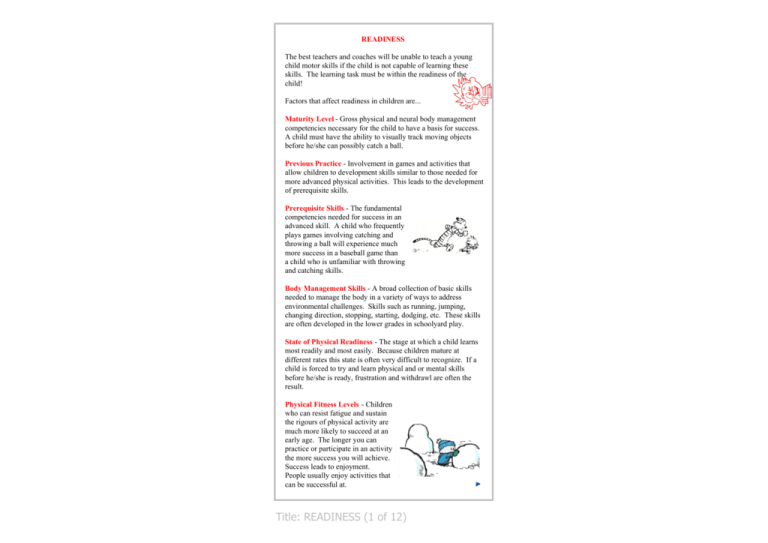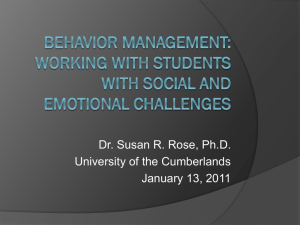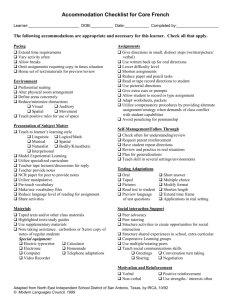MOTOR LEARNING - Factors Affecting Capacity to Learn
advertisement

READINESS The best teachers and coaches will be unable to teach a young child motor skills if the child is not capable of learning these skills. The learning task must be within the readiness of the child! Factors that affect readiness in children are... Maturity Level ­ Gross physical and neural body management competencies necessary for the child to have a basis for success. A child must have the ability to visually track moving objects before he/she can possibly catch a ball. Previous Practice ­ Involvement in games and activities that allow children to development skills similar to those needed for more advanced physical activities. This leads to the development of prerequisite skills. Prerequisite Skills ­ The fundamental competencies needed for success in an advanced skill. A child who frequently plays games involving catching and throwing a ball will experience much more success in a baseball game than a child who is unfamiliar with throwing and catching skills. Body Management Skills ­ A broad collection of basic skills needed to manage the body in a variety of ways to address environmental challenges. Skills such as running, jumping, changing direction, stopping, starting, dodging, etc. These skills are often developed in the lower grades in schoolyard play. State of Physical Readiness ­ The stage at which a child learns most readily and most easily. Because children mature at different rates this state is often very difficult to recognize. If a child is forced to try and learn physical and or mental skills before he/she is ready, frustration and withdrawl are often the result. Physical Fitness Levels ­ Children who can resist fatigue and sustain the rigours of physical activity are much more likely to succeed at an early age. The longer you can practice or participate in an activity the more success you will achieve. Success leads to enjoyment. People usually enjoy activities that can be successful at. Title: READINESS (1 of 12) GOALS AND REWARDS Goals Children and adults can be stimulated and motivated easily when they have a goal that is both challenging and attainable. Children need to feel that they have met a challenge and can then say “I did it!” Goals need to be clearly stated. Goals that may be difficult to reach should be broken down into sub goals to ensure success and to enhance the instructional sequence. Rewards Rewards can be classified as either intrinsic rewards or extrinsic rewards. An intrinsic reward is a mental reward such as the satisfaction of accomplishing something. Internalizing success gives the learner a sense of pride in his/her accomplishments. An extrinsic reward is a visible, touchable, tangible reward such as a medal, a trophy, or a picture in the paper. Something that can be displayed. Title: GOALS & REWARDS (2 of 12) PROGRESSION Logical progression is the heart of the learning process. Progression is defined as moving the learning process through ordered steps from the least challenging to the most challenging. When working with groups it is very difficult to determine the speed at which one works through these steps. What is easily mastered by one individual may be a source of frustration for another. Advancement from one step to the next should not occur until the first step has been practised and mastered. Title: PROGRESSION (3 of 12) MOTIVATION Readiness implies that the child can learn and is ready to learn. Just as importantly, however, the child must want to learn. Capability and readiness have a physical and neural basis while motivation is based on psychological drives. In early childhood development, the concept of “physical education” is often very motivating in itself because at a young age children associate physical action with play and recess. Interest and excitement can easily be generated in children and adults by keeping activities new, different and challenging. When fatigue, boredom or a lack of progress become evident, a change of activity is necessary. Title: MOTIVATION (4 of 12) FEEDBACK Feedback refers to the return of information to the learner regarding performance. Feedback can be internal, in the form of feelings, impressions or concepts derived from the learning experience. Feedback is however most commonly thought of as the return of technical information regarding the correctness and accuarcy of the response. Too much feedback can confuse the learner. In analysing a performance, the instructor should focus the feedback on one or two of the most important points and leave the less vital corrections for another time. • • • • • • • • • • HEAD DOWN LOOSE GRIP BALANCED STANCE FLEXED KNEES WEIGHT FORWARD GOOD ALIGNMENT HIP ROTATION FOLLOW THROUGH SWING PLANE WEIGHT TRANSFER Feedback can at times be misleading to the beginner. For example, putting the basketball through the hoop is an example of positive feedback as you acheived a desireable outcome. However, the action used to acheive that goal my have been completely incorrect. Title: FEEDBACK (5 of 12) FITTS' LAW Fitts' Law is a model of human psychomotor behavior developed in 1954. Results from Fitts' experiments determined that feedback is an essential factor in the process of learning a motor skill. In learning to perform a motor skill the subject must learn to move body parts in correct movement patterns accurately. One way in which the athlete can learn a movement pattern (motor skill) is to monitor the movement of another person while performing the skill. The movement pattern can be monitored using both proprioceptive feedback and exteroceptive feedback (see definitions below). The length of the movement pattern, speed of the movement, and required accuracy of the movement pattern, all greatly affect the athletes ability to monitor his/her own movements. Motor skill learning takes place when an athlete continually monitors movement patterns, corrects the movement, and practices the corrected movement. LEARNING CANNOT TAKE PLACE WITHOUT FEEDBACK • learn to "fizzit" with feedback • learn to "fozzit" without feedback Definitions External Feedback: information returned to the user via outside sources. Examples of external feedback would include verbal responses, visual examples, video sequences, still images, controlled movement. Internal Feedback: feedback from within the user from the CNS (Brain) • Proprioceptive Feedback: all consequences received via sense organs in the musculo­skeletal and vestibular systems (body position, spatial awareness and kinesthetic sense) • Exteroceptive Feedback: visual, auditory and other sensory feedback Title: FITTS' LAW (6 of 12) BASIC FEEDBACK LOOP ORIGINAL IDEA CENTRAL PROCESSING (CNS) RECEPTORS (sense organs) MEMORY MATCHING TAKE ACTION (muscles) INTERNAL FEEDBACK INTENDED OUTPUT OUTPUT CONSEQUENCES PROPRIOCEPTIVE FEEDBACK EXTEROCEPTIVE FEEDBACK EXTERNAL (information) FEEDBACK INSTRUCTOR or COACH MEMORY MATCHING ­ Compare this motion to other actions you are familiar with and transferring movement skills accordingly to perform the skill. INTERNAL FEEDBACK ­ Instantly you can feel what your muscles are doing and make corrections and adjustments if possible PROPRIOCEPTIVE FEEDBACK ­ You can make an immediate evaluation of your own performance after it has been completed based on the feedback from your senses. Did it feel right? Did it hurt? Was my weight transferred smoothly? Did I feel balanced when I landed? EXTEROCEPTIVE FEEDBACK ­ You can make an evaluation of your own performance after it has been completed based on the feedback from your senses. Did I contact the ball in the right place? Did I step over the line? Were my hands positioned correctly on the club? Was I lined up with my target? EXTERNAL (information) FEEDBACK ­ My coach told me that my timing was off. I see on the video that I dropped my head too soon. It looks like I am taking my eye off the ball. I was instructed to take two steps, not three before I jump. Title: FEEDBACK LOOP (7 of 12) REINFORCEMENT Reinforcement refers to a strengthening, a consolidation and a shoring up of learning as a result of feedback. Reinforcement is an important tool in shaping learning behaviour. Behaviour that is regularly reinforced quickly becomes part of a child’s behaviour pattern. A child is reinforced positively when they receive something positive such as praise, encouragement or attention. Removing something negative is also a form of positive reinforcement. A child is reinforced negatively when they receive something negative such as scolding or a detention. Positive reinforcement is much more effective in shaping learning than negative reinforcement. Title: REINFORCEMENT (8 of 12) PART METHOD VS WHOLE METHOD The whole method refers to the process of learning the entire skill or activity in one dose. The part method involves learning individual components of the skill separately until all of these parts are learned, then combining them to form the whole skill. The whole method has proven to be more effective for simple skills. As the skill becomes more complex the teacher must determine (depending on the readiness and ability of the learner) when the task becomes to difficult to master in one dose. At this point the part method should be used. Title: PART VS WHOLE (9 of 12) complex or simple? whole or part? MASSED VS DISTRIBUTED PRACTICE Massed practice refers to taking a large number of trials at once to improve learning while distributed practice refers to spreading out the trials over longer periods of time. Which do you think is more effective? 200 shots on the range in 1 hour or 85 shots on the course over 4 hours. Title: MASS vs DISTRIBUTED (10 of 12) TRANSFER OF MOVEMENT LEARNING A child’s learning efficiency depends in part on how fast he/she can adapt previously learned skills and transfer them to new skill. Transfer is not automatic but occurs more readily when a skill closely resembles previously learned patterns. Transfer of movement learning will occur much more readily if the original task is well learned. Title: TRANSFER (11 of 12) STRESS AND ANXIETY Competition is a major inducer of stress and anxiety, therefore competition during the early stages of learning a complex skill is detrimental. Keep simple drills and learning tasks free of competition. Save competitive activities until the skill has been thoroughly learned by all involved. A stress free environment is much more conducive to learning. Where would you be better focused? Title: STRESS & ANXIETY (12 of 12)








